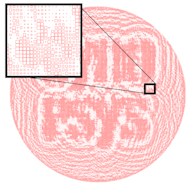Optical design software is used to help optical system designers develop the right configuration of optical elements that manipulate the path of light for their individual optical system or instrument.
Optical designers can start with a suitable design or idea, based on what they want to achieve and their own experience and expertise, and the software can be used to analyse and optimise this idea, to ensure the required performance can be achieved.
It provides the benefit of a reduction in the trial and error process, giving fast, accurate assistance to users. The additional benefit here is a saving in time and money, increased productivity and, arguably, higher optical design quality. In addition, designs can be saved and reused or adapted for future use.
Some of the drivers behind the widespread use of optical design software include demand within the photonics sector, of course, but also in aerospace, where higher quality modelling and analysis of optical systems are vital, likewise the boom in cloud and edge computing and smart consumer technology.
Optical design software tools on the market now
Vendors of optical design software and related products include 3DOptix, which offers free online optical design software. Free to download at the company’s website, the tool allows users to build an optical set-up, use off-the-shelf optical elements or create customised ones and choose different off-the-shelf opto-mechanical parts or import a customised part. With the software, users are also able to run geometrical or ray optics simulation and analyse the design, measure distance and analyse the spectrum.
AEH provides software solutions for design and analysis of metrology, optical instruments and fine mechanics. Its three proprietary software tools are: Ivory, for managing mechanics of images; Ebony, for managing mechanical aberrations; and Jade, for managing mechanics of brittle fractures.
Polaris-M is an optical design and polarisation analysis programme from Airy Optics. The tool joins ray tracing-based optical design methods with polarisation calculus, 3D simulation, anisotropic materials, diffractive optic simulation, stress birefringence and diffraction theory. It was developed at the Polarization Laboratory at the University of Arizona over the last 10 years and licensed in 2016 to Airy Optics. More than 500 functions are included, such as ray tracing, aberration calculation, polarisation elements, stress birefringence, diffractive optical elements, polarisation ray tracing calculus, and liquid crystal cells and optical elements.
BeamWise is a set of software tools and services for the design of biophotonic and other complex optical systems. It is implemented using Design++, a knowledge-based engineering platform that simplifies the capture of in-house engineering expertise and streamlines integration of legacy systems into design automation and product configuration solutions. It has a component library that augments AutoCAD or SolidWorks to make sure the alignment is maintained as design changes are rippled through the beam path.
BeamXpert’s Designer software simulates the propagation of laser radiation through optical systems in real time, offers intuitive operation with CAD-like 3D representation and speaks the language of laser technology. It uses two modelling approaches. The first uses the propagation of the first and second order moments of the intensity distributions for simulation. A proprietary approach allows a less restrictive application of the paraxial approximation. Since the calculation is very fast, the simulation can be performed in real time. In the second model, the laser radiation is represented by a bundle of geometrical-optical beams propagated through the system using classical ray tracing.
Breault Research Organization’s experience and capabilities in optical engineering led to the optical analysis and design software suite, which includes the Asap Optical Performance Prediction Engine, Apex Predictive Optical Analysis Solidworks Integration, and ReflectorCAD Optical Reflector Design Platform. The Apex add-in for the SolidWorks 3D-modelling environment is based on the Asap ray tracing engine, and enables the design and analysis of optical and illumination systems using an easy-to-follow workflow. Asap can accurately predict the real-world performance of virtually any optical system. ReflectorCAD is a reflector design tool that allows graphical adjustments to the luminous intensity pattern corresponding to individual reflector segments.
Crosslight Software is an expert in TCAD (technology computer aided design) simulation tools headquartered in Vancouver, Canada. For almost 20 years, the company has been dedicated to providing state-of-the-art TCAD simulation tools for semiconductor devices and processes. It has three device simulation software packages (Apsys, Lastip and Pics3D), and device models cover a full range of devices, from basic silicon MOSFET to more complex devices such as vertical cavity surface emitting laser (VCSEL) and quantum cascade laser (QCL). Crosslight also developed Procom, a 2D/3D simulator to model semiconductor growth by metal-organic chemical vapour deposition (MOCVD), a technology commonly used to grow compound semiconductors.
Design Workshop Technologies creates computer aided design software for the microelectronics, MEMS and photonics industries, and for other microfabrication applications. Its flagship suite of products is dw-2000, which enables the physical layout and verification of optical components built using planar waveguide technology and other semiconductor manufacturing techniques.
ELE Optics provides cloud-based optical software solutions built by optical engineers, for optical engineers. The software allows for optical project collaboration, version control and deep insights.
Excelitas Technologies offers Linos WinLens Software to streamline optical design utilising the extensive offering of Linos optical elements and components. WinLens is a powerful and intuitive simulation program for designing optical imaging systems. Originating from the Qioptiq heritage, Excelitas offers complimentary versions of WinLens Basic and WinLens Predesigner, for optical education and rudimentary optical design, as well as the full capabilities of WinLens 3D offering a range of software plug-in modules, including Material Editor, Glass Manager and Optical Tolerancer to enable even more advanced optical design.
FTG Software Associates provides the FilmStar Optical Thin Film Software, a suite of Windows programs for designing, manufacturing and measuring optical coatings. Coatings are applied to glass and other surfaces by high vacuum deposition. Its Scantraq is a stand-alone version of FilmStar Measure, marketed to chemists and spectroscopists and supporting UV/Vis/IR data acquisition and analysis from current and legacy PerkinElmer and other models.
Optics simulation and design software from HMS Technology Sales is typically used by optical engineers who also have ray tracing software, such as Zemax and Code V. For applications with feature sizes approaching, and smaller than, the wavelength, we offer software that extends your modelling beyond ray tracing to accurately model diffraction, interference, polarisation, wavefront aberrations and partial coherence. Applications include metalenses, DOEs, beam shaping, CGHs, high NA focusing and beam splitting, gratings, AR/VR, HUD, microlens arrays, fibre coupling, interferometers, spectrometers, ultrashort pulse propagation, pulse stretching and compression and solid-state laser design.
K2realm Extensions is a plug-in that integrates with clients’ current installation of Code V Optical Design Software. Optical design tasks can be improved, alongside lens design workflow. Additional features include quick model changes, faster tolerancing run times and improved data visualisation within the optimisation dashboard
Lambda Research Corporation provides software tools for optical and illumination design. Amongst the company’s products is the TracePro opto-mechanical software, which is popular for its ease of use, CAD interface and accuracy in illumination design. Meanwhile, its Oslo optical design software is known for its power and flexibility in lens design. RayViz is a ray-tracing add-in for Solidworks.
LightTrans International develops and offers fast physical-optics software for optical systems that comprise macro-, micro-, and nano-structured components. By connecting a variety of propagation techniques, LightTrans provides physical optics modelling with high speed, which enables the analysis and design of optical systems beyond ray tracing. VirtualLab Fusion provides a platform for connecting inbuilt and customised electromagnetic field solvers. This approach is designed to enable fast physical optics with ray tracing embedded in a well-defined way.
Luceda Photonics aims to enable photonic IC designers to enjoy the same power as electronic IC designers. The company automates and integrate the complete photonic design flow. Its IPKISS Python-based platform enables design teams to easily share and reuse their photonic design IP using a standard language.
Lumerical’s Device suite of component-level simulation products uses multi-physics-style simulation workflows to model optical, electrical and thermal effects at the physical level. The company’s system suite of system-level simulation products is designed to offer a rich set of analysis capabilities to design and optimise the performance of photonic integrated circuits.
Optiwave Systems is a developer of software tools for the design, simulation and optimisation of components, links, systems and networks for the dynamically growing fields in photonics nanotechnology, optoelectronics, optical networks and other photonic applications. Its software has been licensed to more than 1,000 corporations and universities in over 70 countries worldwide.
Photon Design was started more than 30 years ago to provide professional quality software to the photonics industry. It has introduced many innovations to photonics modelling, and now provides tools for the modelling of active and passive photonics components and circuits. Its products are now in use in more than 30 countries, hundreds of research labs and it has contributed to thousands of research publications.
Photon Engineering is a consulting and software development firm that specialises in all phases of optical engineering: design, analysis and implementation. The company’s Fred optical engineering software simulates the propagation of light through any opto-mechanical system by ray tracing. Whether a design is imported from CAD, a lens design program, or constructed from within the software, Fred provides engineers with a solution for virtual prototyping of optical systems.
PlanOpsim’s software is designed to provide a start-to-finish workflow for the design of meta-lenses and other meta-surfaces. To design meta-surfaces, the software simulates both the tiny nano-structures and larger components made of millions of nano-structures. The software applies a multi-scale optical model to simulate these components effectively. The sub-wavelength meta-atoms are modelled with a full wave solution to Maxwell equations and the component scale simulation is calculated using efficient propagation optics.
Praxis Optics offers contract optical design, analysis and programming services. Its optical systems are used for commercial, defence and biomedical applications. The company can design and provide manufacturability analysis of optical systems using conventional components and aspherics. The optical system can be modelled as it propagates through atmospheric turbulence, including time-dependent fluctuations. The company can also provide scientific programming and analysis services using common analysis packages and C++ programming.
Sciopt Enterprises offers a range of software products for design and analysis of nanoscale optical and laser systems. The company develops and offers Paraxia-Plus-10 software tools for laser system design on Windows-based computers. The software allows for the study of laser resonator characteristics or laser beam interactions with components outside the resonator, or both.
Synopsys provides design tools that model all aspects of light propagation. For metalens design made easier, the RSoft Photonic Device Tools provide the most comprehensive set of optical solvers to design photonic devices and systems. The latest release expands the platform’s capabilities for automated metalens design as well as multi-physics simulations for optoelectronic devices and illumination systems. Find out more.
VPIphotonics offers simulation software and design services that can support the requirements of photonic integrated circuits, semiconductor laser- and fibre-based component applications, optical system and network applications, and optical equipment configuration.
Zemax develops software to help improve the speed and accuracy of optical product design by enabling engineering teams to simulate how light travels through the complete opto mechanical system before building a physical prototype. The company also offers online training courses.
This is not an exhaustive list. If you provide optical design software or related products space and would like your company to be included, please let us know at: editor.electro@europascience.com
Synopsys: Featured optical design software product
How to Build Better Optical Designs with Synopsys Software: Synopsys provides design tools that model all aspects of light propagation for high-accuracy optical product simulations and visualisations. With intelligent, easy-to-use solutions and an expert support team anchored by optical engineers, Synopsys helps organisations deliver superior optics to market faster.
CODE V, LightTools, RSoft Photonic Device Tools, and the LucidShape products help designers to create any optical product – from macro- to nano-scale optics. Develop a broad range of optical systems with unparalleled speed and accuracy, such as augmented reality headsets, head-up displays, smartphone optics, automotive lighting, and electro-optical imaging systems.


